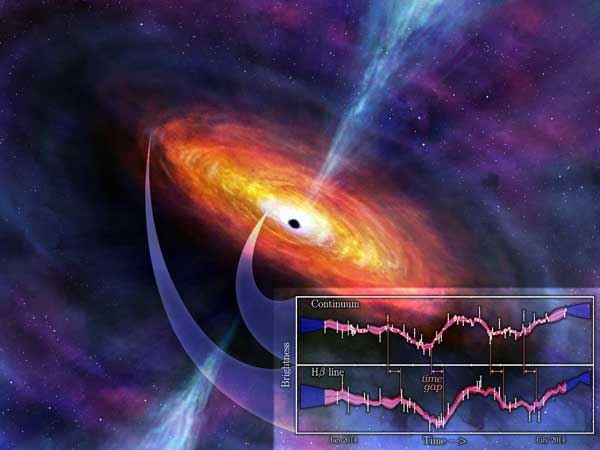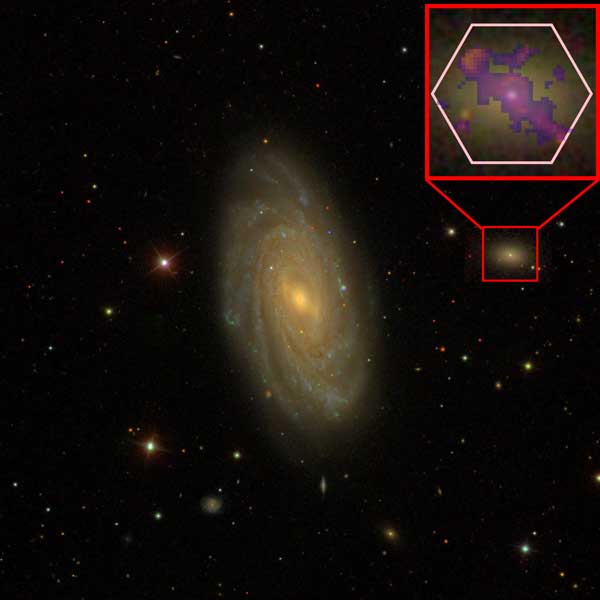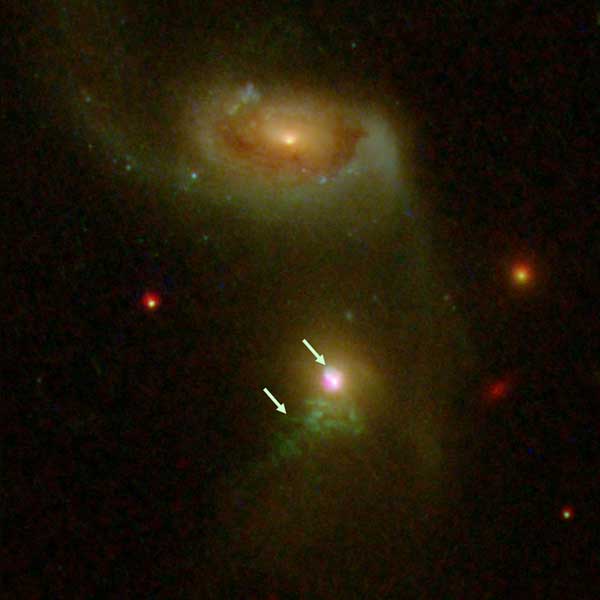Supermassive black holes are beasts — they're difficult to observe and measure, yet their effects on their host galaxies are profound. Read up on the latest black hole discoveries.
Despite their name, supermassive black holes are tiny relative to their galaxies. Still, they typically have masses of millions or billions times the mass of the Sun, guzzle any gas nearby, and pump out plasma, heat, and radiation at levels that effect the evolution of their hosts. We're still trying to understand how these black holes and their host galaxies evolve over cosmic time. Astronomers at the American Astronomical Society meeting in Washington D.C. presented some recent findings that will change our understanding of how supermassive black holes affect the galaxies they live in.
“Weighing” Supermassive Black Holes
Measuring the mass of a supermassive black hole is harder than you would think — you can’t exactly pop it on a scale. Astronomers can’t observe them directly in telescopes either (at least, not yet). For relatively nearby galaxies hosting black holes in their cores, astronomers can measure the motion of central stars and gas to obtain a precise measure of the mass within them, but at greater distances even those central motions can’t be resolved.
So astronomers use a technique called reverberation mapping. Gas-guzzling black holes emit light at constantly changing levels, depending on how much gas the black hole is feeding on. This light strips electrons off gas in faraway clouds, which emit their own light at specific wavelengths. By observing how long it takes for a change nearer the black hole to travel out to the clouds, as well as measuring the motions of the clouds themselves, astronomers can precisely gauge the mass of the black hole that the clouds are orbiting.

Nahks Tr’Ehnl (www.nahks.com) and Catherine Grier (Penn State) and the SDSS collaboration
This spectroscopic technique has mostly been applied to relatively nearby black holes, in part because it takes a lot of observing time to obtain a single measurement. But now Catherine Grier (Penn State) and colleagues have used the Sloan Digital Sky Survey to measure black holes masses in this way out to almost 8 billion light-years away, when the universe is about half its current age. The project, which began in 2014 and has collected 44 black hole masses so far, is still ongoing, with many more to come. A large sample of black holes near and far with accurate masses will help Grier and others understand how black holes evolved alongside their host galaxies.
Revenge of the Dwarf Galaxies
Even dwarf galaxies can experience the wrathful feedback from supermassive black holes. Black holes with the mass of millions or billions of Suns are known to emit winds, jets, and radiation that can quench star formation in their host galaxies. But dwarf galaxies have central black holes with smaller masses and less activity.
Samantha Penny (University of Portsmouth, UK) and colleagues observed 69 dwarf galaxies that are no longer forming stars using the Mapping Nearby Galaxies at Apache Point Observatory (MANGA) survey. Most of these dead dwarfs live in crowded environments, where interactions with other galaxies have pulled away star-forming gas. However, six galaxies appear to have quenched star formation on their own thanks to the supermassive black holes that lurk in their cores.
MANGA spectra show the motions of stars and gas throughout the galaxy, revealing the signature of galactic-scale heating driven by supermassive black holes. This is the first time feedback has been seen from such small black holes — while exact masses aren’t known, they’re probably less than a million solar masses each.

Samantha Penny (University of Portsmouth) and the SDSS collaboration
Black Hole Feasts and Burps, Twice
Astronomers have witnessed a black hole’s eating habits using the Hubble Space Telescope and Chandra X-ray Observatory. Julie Comerford (University of Colorado, Boulder) and colleagues published the results in the Astrophysical Journal.
The astronomers stumbled upon the nearby galaxy SDSS J1354+1327, discovering evidence for two black hole “burps” separated by roughly 100,000 years. Supermassive black holes feed in bursts, guzzling gas that unleashes radiation as it spirals inward. That radiation lights up the surroundings, stripping electrons off of neutral gas.
In SDSS J1354, a cone of ionized gas extends 30,000 light-years south of the galaxy’s center, evidence of a feast roughly 100,000 years ago. A shock wave 3,000 light-years north of the galaxy’s center from the black hole suggests a more recent snack. The two meals were probably the result of interactions with a nearby companion galaxy.

 2
2









Comments
Rod
January 21, 2018 at 6:33 pm
I have read a number of reports that some supermassive black holes (SMBH) have growth rate problems in the big bang model. A number are too big to have grown in < 1 billion years after the big bang, e.g. ULAS J1342+0928. Q: How could SMBH grow so quickly? Ref - Oldest Supermassive Black Hole Found from Universe’s Infancy, https://www.scientificamerican.com/article/oldest-supermassive-black-hole-found-from-universe-rsquo-s-infancy/
You must be logged in to post a comment.
Monica YoungPost Author
January 22, 2018 at 10:25 am
Rod, that's a great question with no definite answer. You might be interested in Camille Carlisle's feature article on the topic in the January 2017 issue of Sky & Telescope.
You must be logged in to post a comment.
You must be logged in to post a comment.